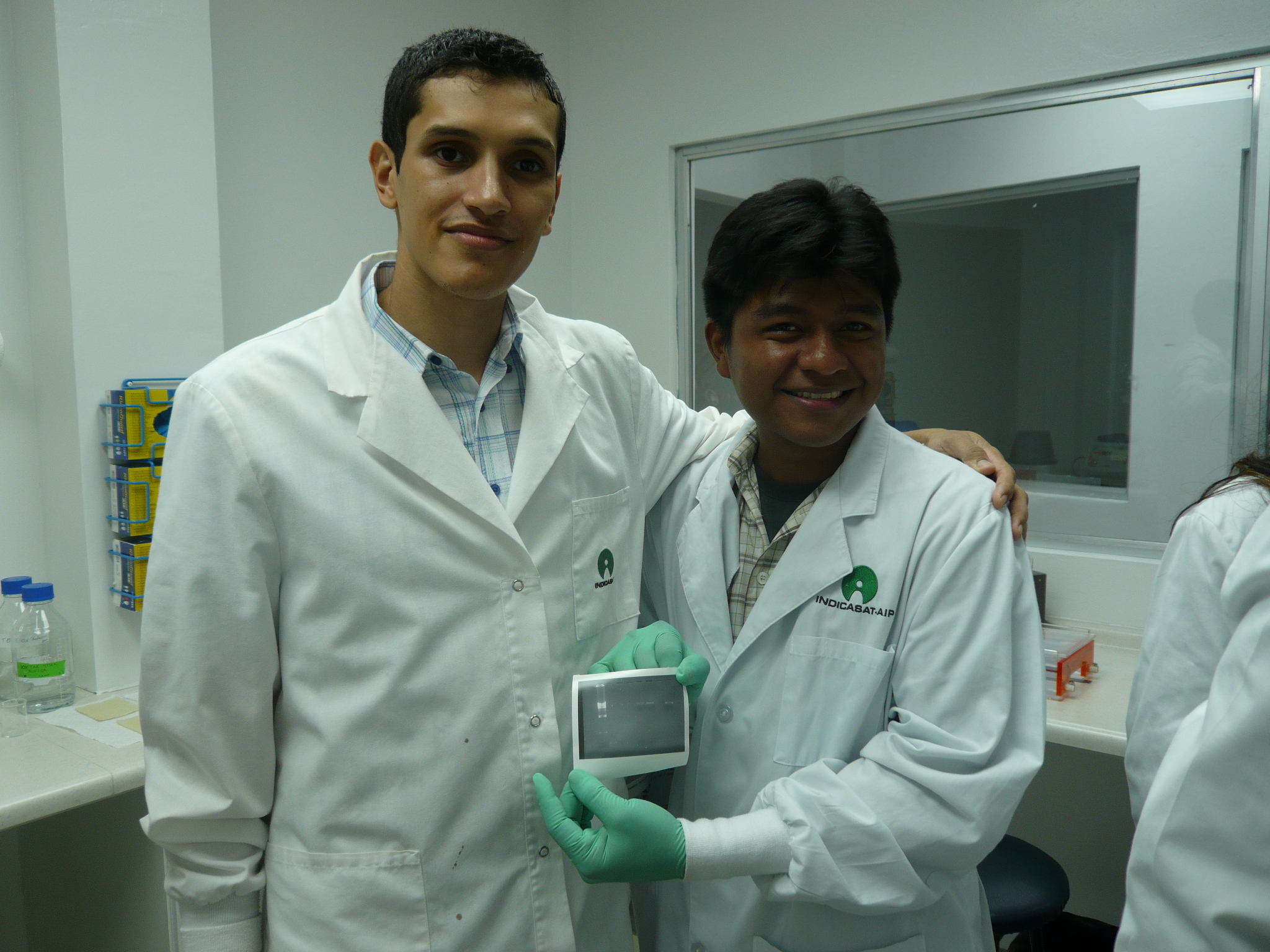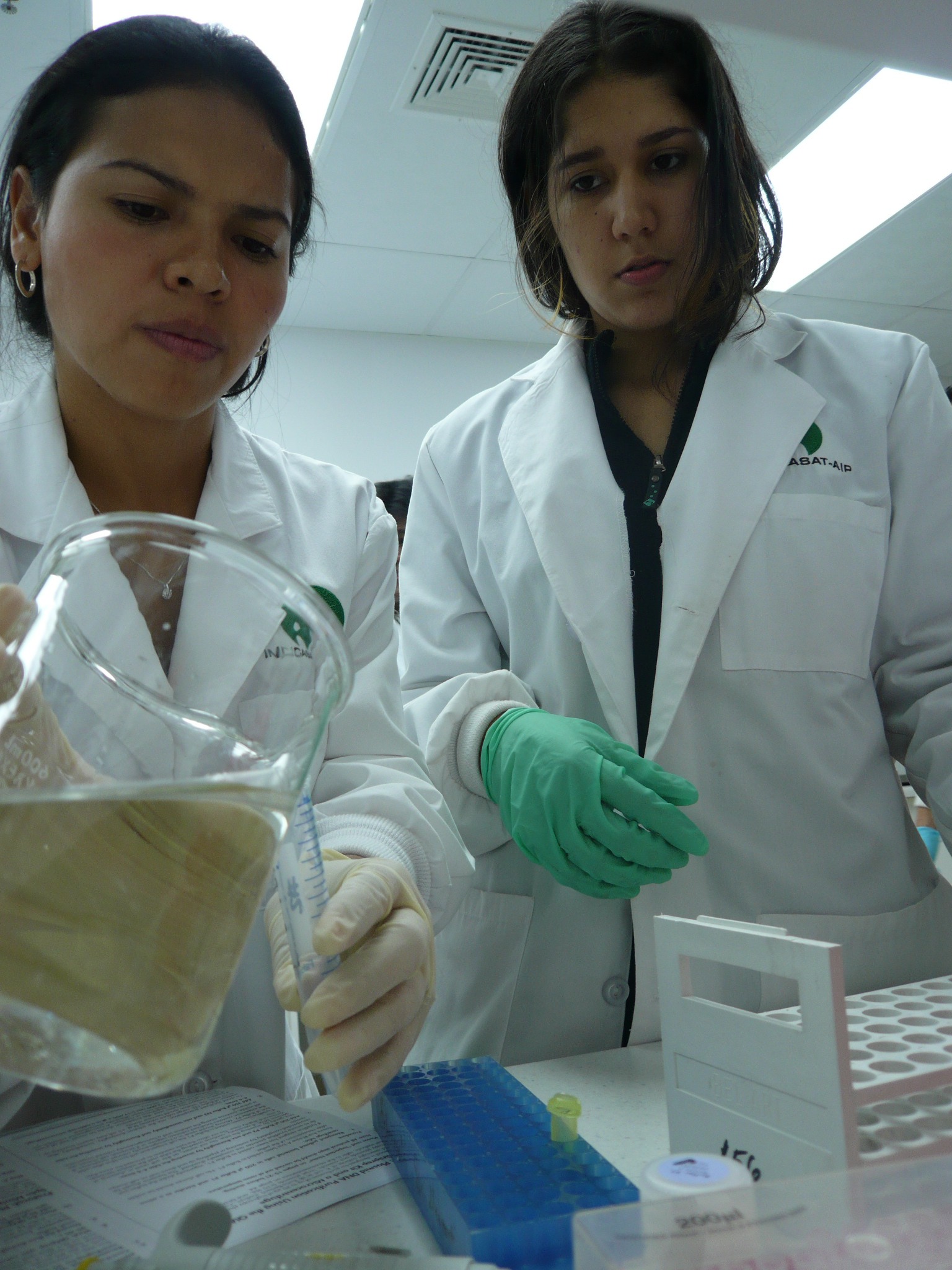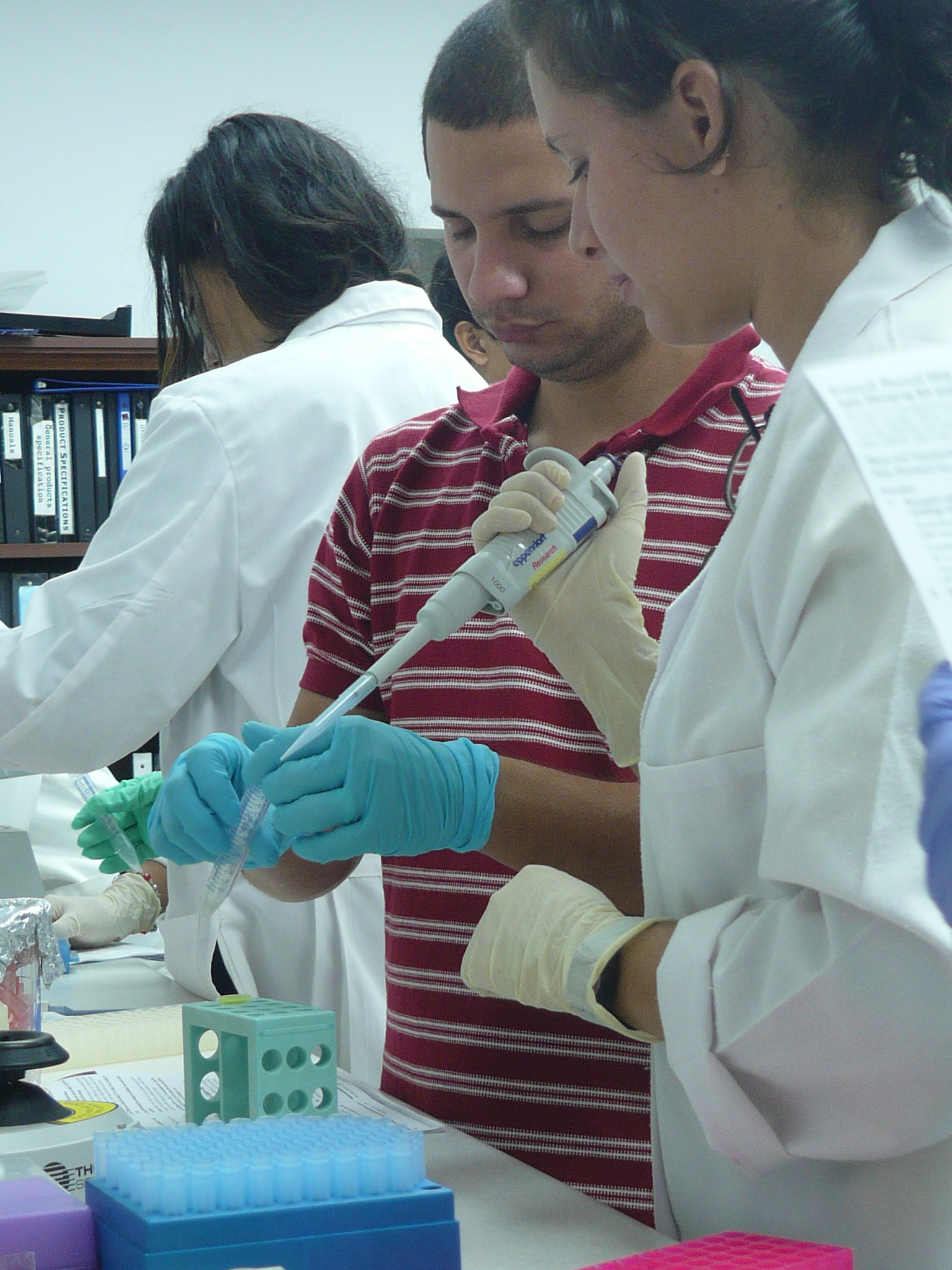|
|
| (55 intermediate revisions not shown) |
| Line 1: |
Line 1: |
| - | {{:Team:Panama/Header}} | + | {{:Team:Panama/Header2}} |
| | ====Notebook==== | | ====Notebook==== |
| - | ===Idea Project===
| |
| - | Development of a genetically engineered ''E. coli'' that can produces the rhamnosyltranferase 1, for the production of a biosurfactant.
| |
| - |
| |
| - | Steps to follow:
| |
| - | 1.Find the gene sequences in pubmed.
| |
| - | 2.In which bacteria is found.
| |
| - | 3.After we found the gene, we designed two different set of primers.
| |
| - | 4.Look for the sequences of the restriction enzymes E, X, P and S, inside the gene sequence.
| |
| - | 5.If we found in the gene sequence a recognition sequence for the restriction enzymes.
| |
| - | 6. So we should look for a mutagenesis protocol or kit.
| |
| - | 7.We choose the Stratagene lightning mutagenesis kit. We also design three different set of primers, because the base pairs that surround the PstI unwanted sequence were different.
| |
| - |
| |
| - | ===Meeting July 21===
| |
| | | | |
| | + | {{:Team:Panama/calendar2}} |
| | | | |
| | + | <center> |
| | <gallery> | | <gallery> |
| - | Image:Panama-21-7-10-01.JPG| | + | Image:INDICASAT-11.JPG| |
| - | Image:Panama-21-7-10-02.JPG| | + | Image:INDICASAT-05.JPG| |
| - | Image:Panama-21-7-10-03.JPG|
| + | Image:INDICASAT-02.JPG| |
| - | Image:Panama-21-7-10-05.JPG|
| + | |
| - | Image:Panama-21-7-10-06.JPG| | + | |
| - | Image:Panama-21-7-10-07.JPG|
| + | |
| - | Image:Panama-21-7-10-08.JPG|
| + | |
| | Image:DSC04818.JPG| | | Image:DSC04818.JPG| |
| | | | |
| - | </gallery>
| |
| - | ===Meeting June 26===
| |
| - | At this moment we have two ideas to develop. We are debating which idea is more feasible.
| |
| - | Idea #1: Carlos´s team idea
| |
| - | We want to produce Rhamnolipid in bacteria (''E.coli'') to use it as a biosurfactant.
| |
| - | We have to see how we can isolate the rhamnolipid and be sure that the translation is functional.
| |
| | | | |
| - | <gallery>
| |
| - | Image:ErnestoIdea.jpg|Ernesto's Idea
| |
| - |
| |
| - | </gallery>
| |
| - |
| |
| - | Steps to follow:
| |
| - |
| |
| - | 1.Amplified the Rhamnosyltransferase 1 complex from ''Pseudomona auruginosa'' and clone this fragment. Size aprox 2.2 Kb.
| |
| - | 2.Ligation / Transformation
| |
| - | 3.Expression with reporter gen.
| |
| - | 4.Isolation
| |
| - | 5.Is the protein functional?
| |
| - | 6.Make sure that the rhamnolipid is produced in prescence of rhamnose and fatty acid.
| |
| - |
| |
| - |
| |
| - | Notes:
| |
| - |
| |
| - | We can see the reaction (enzymatic measure) by spectrometry.
| |
| - | See kind of ligation.
| |
| - |
| |
| - |
| |
| - | But first, before the amplification we need to design our primers.
| |
| - |
| |
| - | Primers design:
| |
| - |
| |
| - | 1.Check the gene sequence (In GenBank, FASTA format)
| |
| - | 2.Design the primer sequence.
| |
| - | 3.See kind of cloning.
| |
| - | 4.M13 tail for cleavage site.
| |
| - | 5.Look for cleavage site inside the rhamnosyltransferase 1 gene for our restriction enzymes. We can´t cut our gene in the process.
| |
| - |
| |
| - |
| |
| - | In summary the steps that we need to follow are:
| |
| - |
| |
| - | I.Primer design
| |
| - | II.PCR or amplification
| |
| - | III.Cloning
| |
| - | IV.Expression
| |
| - | V.Sequencing
| |
| - |
| |
| - | The most important steps are I and II. We need a good primers design and PCR if we want to have successful.
| |
| - |
| |
| - |
| |
| - | Idea #2
| |
| - | Ernesto team´s idea
| |
| - |
| |
| - | Production of Cecropin compound. We want to produce the antibacterial cecropin compound. Naturally it is produced by insects and plants.
| |
| - |
| |
| - | We want to use ''Anopheles gambiae'', cecropin precursor. The gene is about 550 pb.
| |
| - |
| |
| - |
| |
| - |
| |
| - |
| |
| - | The steps to follow are the same in both groups.
| |
| - | Both groups have to design the primers, and have all the experimental design for this week.
| |
| - |
| |
| - | 1.The sequence of the interested gene.
| |
| - | 2.Design the primers. (50-100pb more at the beginning and end of the sequence).
| |
| - | 3.Check for cloning sites. Which plasmid we are going to use, identify the restriction enzymes.
| |
| - | 4.Assemble the blocks. In paper assemble all the system. Promoter + Ribosomal binding site + interest gene + reporter gene + translation end site.
| |
| - |
| |
| - |
| |
| - | All the design has to be on paper to analyze them and decided which idea is going to be the elected one.
| |
| - |
| |
| - | ===Wetlab 103: Let's make an ''E. coli'' that fluoresce (or some simple BioBrick project)===
| |
| - | * Instructor: INDICASAT, Dr. Carmenza Spadafora
| |
| - | * Date: (17h00-20h00 11th of June)
| |
| - | * Venue: INDICASAT
| |
| - | * Description: We identify a simple project based on past iGEM work and do our first BioBrick protocol project. Nothing innovative, but an opportunity to practice the protocols.
| |
| - | <gallery>
| |
| - | Image:INDICASAT-01.JPG|INDICASAT
| |
| - | Image:INDICASAT-02.JPG|INDICASAT
| |
| - | Image:INDICASAT-03.JPG|INDICASAT
| |
| - | Image:INDICASAT-04.JPG|INDICASAT
| |
| - | Image:INDICASAT-05.JPG|INDICASAT
| |
| - | Image:INDICASAT-06.JPG|INDICASAT
| |
| - | Image:INDICASAT-07.JPG|INDICASAT
| |
| - | Image:INDICASAT-08.JPG|INDICASAT
| |
| - | Image:INDICASAT-09.JPG|INDICASAT
| |
| - | Image:INDICASAT-10.JPG|INDICASAT
| |
| - | Image:INDICASAT-11.JPG|INDICASAT
| |
| - | Image:INDICASAT-12.JPG|INDICASAT
| |
| - |
| |
| - |
| |
| - | </gallery>
| |
| - |
| |
| - | ===Wetlab 102: Let's raise a few E. coli===
| |
| - | * Instructor: Lorena Coronado and and Dr. Carmenza Spadafora
| |
| - | * Date: (17h00-20h00 11th of June)
| |
| - | * Venue: INDICASAT
| |
| - | * Description: How does one handle ''E. col''i?
| |
| - | <gallery>
| |
| - | Image:INDICASAT_LECTURE-29.JPG
| |
| - | Image:INDICASAT_LECTURE-30.JPG
| |
| - | Image:INDICASAT_LECTURE-31.JPG
| |
| - | Image:INDICASAT_LECTURE-32.JPG
| |
| - |
| |
| - | </gallery>
| |
| - | ===Wetlab 101: Tools of the lab and their use===
| |
| - | * Instructor: Dr. Patricia Llanes
| |
| - | * Date: (17h00-20h00 9th June)
| |
| - | * Venue: INDICASAT
| |
| - | * Description: How to handle pipettes, clean test tubes, etc.
| |
| - | <gallery>
| |
| - | Image:INDICASAT_LECTURE-19.JPG
| |
| - | Image:INDICASAT_LECTURE-21.JPG
| |
| - | Image:INDICASAT_LECTURE-22.JPG
| |
| - | Image:INDICASAT_LECTURE-23.JPG
| |
| - | Image:INDICASAT_LECTURE-24.JPG
| |
| - | Image:INDICASAT_LECTURE-25.JPG
| |
| - | Image:INDICASAT_LECTURE-26.JPG
| |
| - | Image:INDICASAT_LECTURE-27.JPG
| |
| - | Image:INDICASAT_LECTURE-28.JPG
| |
| - | </gallery>
| |
| - |
| |
| - | ===iGEM workshop follow up: Safety, ethics===
| |
| - | * Instructor: Dr. Ricardo Lleonart
| |
| - | * Date: (17h00-20h00 9th of June)
| |
| - | * Venue: INDICASAT
| |
| - | * Description: There is definetly a "safety considerations" requirement and we should address it early.
| |
| - | <gallery>
| |
| - | Image:INDICASAT_LECTURE-14.JPG|Dr. Ricardo Lleonart
| |
| - | Image:INDICASAT_LECTURE-15.JPG|Dr. Ricardo Lleonart
| |
| - | Image:INDICASAT_LECTURE-16.JPG
| |
| - | Image:INDICASAT_LECTURE-17.JPG
| |
| - | Image:INDICASAT_LECTURE-18.JPG
| |
| - | </gallery>
| |
| - |
| |
| - | ===iGEM workshop follow up: Software tools===
| |
| - | * Instructor: Patrick / Sara
| |
| - | * Date: (17h30-20h00 Monday 7th June)
| |
| - | * Venue: INDICASAT
| |
| - | * Description: Software tools available from the workshop.
| |
| - | <gallery>
| |
| - |
| |
| - | Image:INDICASAT_LECTURE-13.JPG|Dra. Sara Pinzon
| |
| - |
| |
| - | </gallery>
| |
| - | ===DNA 104: BioBricks Protocol===
| |
| - | * Instructor: Sara/Patrick
| |
| - | * Date: (17h30-20h00 Monday 7th June)
| |
| - | * Venue: INDICASAT
| |
| - | * Description: Introduction to the BrioBricks protocol
| |
| - | <gallery>
| |
| - | Image:INDICASAT_LECTURE-09.JPG|Dr. Patrick Nee
| |
| - | Image:INDICASAT_LECTURE-10.JPG
| |
| - | Image:INDICASAT_LECTURE-11.JPG|Dr. Patrick Nee
| |
| - | Image:INDICASAT_LECTURE-12.JPG|Dr. Patrick Nee
| |
| - | </gallery>
| |
| - | ===INDICASAT lecture: Innovation===
| |
| - | * Instructor: Dr. Jagannatha Rao, Director of INDICASAT
| |
| - | * Date: (17h30-20h00 Friday 4th June)
| |
| - | * Venue: INDICASAT
| |
| - | * Description: Dr. Rao's lecture on how to innovate.
| |
| - | <gallery>
| |
| - | Image:INDICASAT_LECTURE-02.JPG
| |
| - | Image:INDICASAT_LECTURE-04.JPG
| |
| - | Image:INDICASAT_LECTURE-08.JPG
| |
| - | </gallery>
| |
| - | ===INDICASAT lecture: Drug discovery in nature===
| |
| - | * Instructor: Dr. Sergio Martinez
| |
| - | * Date: (17h00-20h00 Thursday 3rd June)
| |
| - | * Venue: INDICASAT
| |
| - | * Description:Would be a brainstorming session as students start thinking about projects. It would be GREAT if we could take a molecule discovered by INDICASAT in coral/frogs/nature and put it in ''E. coli''!...
| |
| - | ===DNA 103: DNA modification, plasmids===
| |
| - | * Instructor: Dr. Abby Guerra
| |
| - | * Date: 26 May 17h00-20h00
| |
| - | * Venue: UTP
| |
| - | * Description:Introduction to long tested combinant DNA techniques, the role of plasmids in bacteria, and their use as a vector for DNA modification.
| |
| - | <gallery>
| |
| - | Image:Panama-05.JPG|Dr. Abby Guerra
| |
| - | Image:Panama-06.JPG|Dr. Abby Guerra
| |
| - | Image:Panama-07.JPG|Dr. Abby Guerra
| |
| - | </gallery>
| |
| - |
| |
| - | ===DNA 102: Protein creation relationship to cellular function. 26 May===
| |
| - | * Instructor: Dr. Abby Guerra
| |
| - | * Date: 26 May 17h00-20h00
| |
| - | * Venue: UTP
| |
| - | * Description: Introduction to how DNA drives cellular functions by creating proteins
| |
| - | <gallery>
| |
| - | Image:Panama-02.JPG|Dr. Abby Guerra
| |
| - | Image:Panama-03.JPG|Dr. Abby Guerra
| |
| - | </gallery>
| |
| - |
| |
| - | ===DNA 101: Information store, replication. 26 May===
| |
| - | * Instructor: Dr. Abby Guerra
| |
| - | * Date: 26 May 17h00-20h00
| |
| - | * Venue: UTP
| |
| - | * Description: A basic refresher course on how DNA stores information in the cell, and how it is involved in cellular replication.
| |
| - | <gallery>
| |
| - | Image:Panama-01.JPG|Dr. Abby Guerra
| |
| - | Image:Panama-04.JPG|Dr. Abby Guerra
| |
| | </gallery> | | </gallery> |
| | + | </center> |
 "
"










